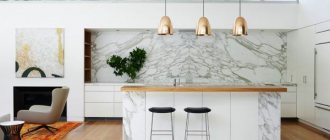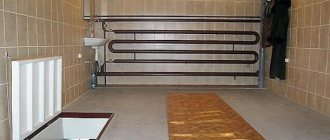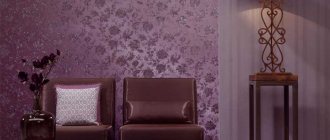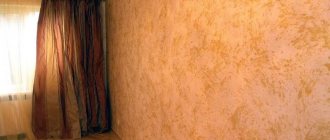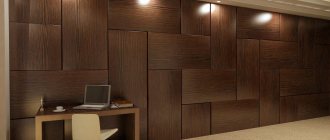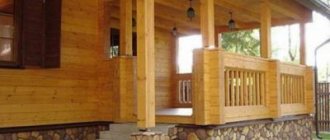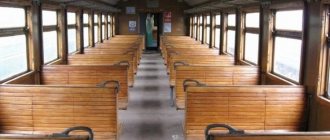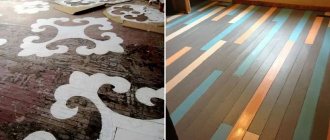Block house is a universal finishing material. It is attached to the walls like a lining, strong and durable. But there are many types of block house, each has its own characteristics and will look different after installation, so let's figure it out. This article is dedicated to block house. You will find a detailed description of the material and our range on the catalog page.
catalog
We talked in detail about the main characteristics and advantages of a block house on our catalog page. Today we’ll talk about the technology of interior finishing with a block house.
What is a blockhouse
Blockhouse is a wall finishing material that is attached to the walls in the same way as lining. A wall lined with a blockhouse looks like a wooden frame made of logs or timber. Initially, this material was intended for exterior decoration. But recently it has increasingly begun to be used for interior decoration of premises for any purpose.
There are three types of blockhouse. It comes in wood, vinyl and metal. Each of these finishing material options imitate wooden beams or logs, but their performance characteristics are different. A metal blockhouse is a good modern material for exterior decoration. But it is not used for interior work.
Metal block house for exterior decoration Source ro.decorexpro.com
Wooden blockhouse
It is made from high-quality wood and has decent performance characteristics. Finished panels have high resistance to humidity, temperature changes, direct sunlight and mechanical stress.
The wooden house block is made from oak, larch, aspen, ash, cedar, and pine. In width it can be narrow (140 by 270 mm) and wide (190 by 45 mm). These are average sizes; they may vary slightly among different manufacturers. The length of the panels can be from 2 to 6 meters.
By quality, this material is divided into 3 grades - “Extra”, A, B and C. The highest quality products do not have any flaws and are produced under the “Extra” brand. The interior cladding of a house block is made primarily from this type of panel. The lowest grade is C.
Extra class block house Source angarsk-kedr.ru
See also: Catalog of companies that specialize in finishing materials.
Vinyl blockhouse
A vinyl blockhouse looks similar to a wooden one, but is made using PVC. Vinyl panels consist of two layers. The front layer provides the finish with aesthetics and protection from external influences. The second layer is needed to give the panels strength. When purchasing such material, you need to pay attention to the color of the outer and back layers. High-quality panels are the same color on both sides.
Vinyl blockhouse has higher performance characteristics. But it is not an environmentally friendly material like wood panels. Therefore, for interior decoration it is used mainly in rooms with high humidity or in unheated areas. The interior decoration of a block house is mainly wood trim.
Vinyl block house under timber Source na-stroyke.ru
Criterias of choice
The choice of finishing method for the premises of an apartment or residential building directly depends on the financial viability and taste preferences of the home owner. If we compare the cost per square meter of surface covered with clapboard, imitation timber or block house, then the latter has the highest. At the same time, it best conveys the spirit of antiquity, combining elements characteristic of wooden architecture of the 18th – 19th centuries with modernity. Cladding a block house makes it possible to find stylish design solutions, while avoiding the use of complex carpentry technologies, which, by the way, are not mastered by modern finishers.
How to choose a wooden blockhouse
There are several important factors to consider when choosing wood trim.
- Conifers . Coniferous wood is usually used to decorate bedrooms and living rooms. The subtle scent of pine gives these rooms a cozy homely atmosphere. But when heated strongly, coniferous wood releases a lot of resins, so it is better to use deciduous wood in bathrooms, saunas and kitchens.
- Humidity . For rooms with high humidity, you need to choose wood with appropriate properties. Moisture-resistant wood materials, with proper care, can last for decades in bathroom or kitchen decoration.
- Hardness _ The more difficult the operating conditions of the room, the harder the wood should be used for finishing. To determine the strength of a particular tree, you can use special tables.
Wood hardness table Source mauro-gianvanni.ru
- Appearance . Each type of wood has its own individual appearance, so when choosing, you also need to take into account the aesthetic characteristics of the material.
- Width . Narrow panels are usually used inside houses, since wide ones look too massive in the interior, and if they imitate a log, they also “eat up” a lot of space in the rooms. However, a wide blockhouse, which gives the interior a special flavor, is also often used.
Interesting use cases
When decorating the interior of a block house, various design solutions can be used. The photo shows the most original decoration options.
Wall decoration can be:
- complete - the ceiling and all walls in the room are sewn up with a house block;
- combined - in this case, one or more walls of the room are decorated with finishing material.
Combined
A complete
block house can be organically combined with other decorative elements, for example, lining, wallpaper or textured plaster. Natural material goes well with stone or glass, as well as forged decorative elements. The use of wooden panels for wall decoration allows decorators to bring to life the most original ideas and unusual solutions. Vivid examples of decoration can be seen in the photo.
With the help of wooden panels, decorators recreate the interior decor of a merchant's farmstead or a simple peasant house. If desired, you can create in your living space the atmosphere of a hunting lodge or the cozy design of an Alpine chalet.
Wall decoration with natural, eco-friendly materials is carried out in the living room, bedroom or children's room. Examples of decorating living rooms can be seen in the photo gallery. Wooden panels are often used to decorate auxiliary buildings. These include baths and saunas. The photo selection contains options for decorating the walls of the steam room and dressing room.
Decorators choose block house panels to create beautiful landscape design. The building material is used to decorate fences, gazebos or open terraces.
Technology for using a blockhouse inside
Installation of the cladding is carried out on a lathing made of slats 30-40 mm thick. In this way, panels can be mounted on any walls, regardless of the wall building material.
If it is necessary to insulate the internal walls, you can lay insulation inside the house during the blockhouse cladding process. In this case, the thickness of the sheathing bars should be greater.
Most often, during interior work, the blockhouse is installed horizontally, as when cladding facades. But in some cases, vertical installation is used. For example, in rooms with high humidity and steam formation, it is better to lay the panels vertically so that moisture does not accumulate in the connecting grooves.
Installation of a blockhouse indoors Source hi.decorexpro.com
Vertical installation is also used to visually increase the height of the ceilings in the room. This option is ideal for spacious rooms with disproportionately low ceilings.
Before installation, the blockhouse should be unpacked and left without packaging for several days. This is necessary so that the wood acquires the humidity of the room in which it will be installed. If this is not done, then the material may become deformed during operation.
How to sheathe step by step instructions:
Surface preparation
The work on cladding the internal walls begins with choosing the type of block house. A decision is made on the size and quality of the panel used. In interior spaces there is no need to use thick material. Therefore, in the absence of special circumstances, choose dimensions of 28x140 or 36x190 mm, based on the intended design and installation method. The quality of the material must correspond to level A or AB. Next, the wall surface is cleaned of old paint and varnish coatings, excessive unevenness, damage by fungus and parasitic insects are eliminated. The preparation ends with double impregnation with a fire-retardant compound or antiseptic.
Installation
The first sheathing bars are installed on both sides of the sheathed surface. Section 50x50 mm. A prerequisite is straightforwardness. Ideally, use chamber-drying planed timber. The position of the exposed bars is controlled by the building level. The use of a laser level will ensure greater installation accuracy. Next, threads are stretched at the top and bottom of the starting bars, along which the remaining elements of the sheathing are placed. The method of fastening the sheathing depends on the wall material. For brick, concrete, etc. materials, bolt fastening is used. Holes in the wall for bolts are made using a hammer drill.
Bolt
If the wall being sheathed is made of timber or logs, it is desirable that the fastening of the sheathing is not disturbed if it shrinks. For this purpose, vertical cuts are made in the sheathing beams in the places where the self-tapping screws are installed, allowing the wall elements to make small movements “up and down.” The sheathing remains motionless.
If the house is warm enough, then the installation of a block house indoors can be done without installing additional insulation. On the other hand, since some useful area of the home is still lost, additional insulation will not hurt. In addition, insulation reduces the passage of sound through the walls. Mineral wool is used as insulation material.
Important! When installing insulation, it is necessary to use vapor barrier membranes to prevent it from getting wet.
Attaching the block house to the sheathing is done:
- using clamps;
- self-tapping screws;
- galvanized nails.
If self-tapping screws are used, holes are drilled along the diameter of their heads, which, after installing the house block panel, are closed with wooden plugs. This technology is labor-intensive, but makes it possible to make the attachment points unnoticeable.
The greatest difficulty in the process of covering a block house is the corners of the room. Professionals perform them by imitating the laying of logs in a log house, which is labor-intensive and requires good carpentry skills. You can simplify the task by joining through a beam or covering the corner with a decorative overlay.
Docking through timber. Decorative overlay.
The assembled house block is coated with impregnation, which protects the wood from darkening under the influence of sunlight. It is possible to use tinting compounds and varnishes. Their color and degree of gloss depends on the interior design solution. The joints of the panels are sometimes decorated with rope of the appropriate diameter, simulating inter-crown insulation.
Finish care
Despite the fact that the panels undergo special treatment during manufacturing, it is advisable to coat them with a protective agent. For protection, wax or varnish is most often used. But besides this, there are also all kinds of stains and primers. The treated finish can be cleaned with a damp sponge or vacuum cleaner. Washing them using detergents and abrasive compounds is not recommended.
With the help of protective coatings, you can not only protect the finish, but also give it the desired shade and shine, and highlight the texture. Any coating will last at least 5 years. After this, you need to treat the wall with a new protective compound.
Coating wooden panels with a protective composition Source bv73.ru
Care tips and advice
Service life and appearance depend not only on the initial choice of building material and its correct installation, but also on subsequent care and careful treatment. Simple steps to care for the skin will protect it from external factors and deformation. After installing the panels, they are coated with a primer, then a wax-based varnish is applied.
After waiting for the varnish to dry completely, the surface is sanded with sandpaper, then several layers of varnish are applied again.
During operation, you should periodically remove dust from the surface with a vacuum cleaner and carry out wet cleaning. It is recommended to renew the coating every five years. This procedure will not only increase the service life, but will also renew the appearance and shine of the panels.
Video description
Options for interiors using a block house.
A block house can be used for cladding a frame house. If you use the same finish on the outside and inside of the building, it will look like a real wooden frame. Since frame buildings need insulation, paneling is ideal for them. Under it you can hide insulating and insulating layers.
Unlike smooth surfaces, panel walls visually narrow the space of the room. However, this does not mean that a blockhouse cannot be used in the design of small rooms. It just needs to be combined with other finishing materials. For example, one wall in a room can be lined with panels, and the rest can be plastered and painted in a light color. A block house in the interior of a house, most of the walls of which are plastered, acts as an advantageous interior accent.
Blockhouse and plaster in the interior of the house Source myhome.ru
When finishing spacious rooms, a blockhouse can be combined with other natural facing materials - stone, tile, brick. As an option, a living room lined with wood panels can be complemented with a brick wall. This will create a modern eclectic design that combines loft style with rustic style.
Blockhouse and brick in the interior of the house Source ar-al.com
Natural textiles look great against a wooden wall. When decorating rooms with wood trim, it is better to use draperies in noble colors, avoiding too “flashy” unnatural shades. Cladding a block house inside a house allows you to use a wide variety of curtains, tablecloths, bedspreads, sofa cushions, etc. in interior design.
Combination of block house with textiles Source oz90.ru
When creating an authentic wooden house, a block house is often combined with other wood materials, such as boards and lining. This is done in order to completely cover the room with wood.
Wooden panels, boards and beams in the living room interior Source uk.aviarydecor.com
In a room decorated with block houses, various forged decorative elements look good. They give the interior respectability and noble gloss. To maintain the solidity of your home, you need to complement it with expensive furniture and exquisite decorations. For example, you can decorate a wall with antique weapons or designer porcelain items.
Forged staircase in a house with wooden trim Source stolyarka-39.ru
A blockhouse in the form of a log allows you to create an interior in the Russian merchant style. In this case, you should furnish the room with massive carved furniture made of dark expensive wood, drape the windows with heavy thick curtains with ornaments, and hang a lamp with a round lampshade.
Interior in merchant style Source aviarydecor.com
Another version of the Russian architectural trend is the peasant style. It is also easily implemented in rooms with block house finishing. Unlike the merchant style, the peasant style is simpler, even ascetic. When using it, you can cover the floor with a board with scuffs, install decorative ceiling beams, decorate the premises with ceramic dishes, dried bouquets of wild flowers, mats and coarsely woven tablecloths.
Rustic style in the interior of the house Source roomester.ru
Wooden panels are used for country or chalet style interiors. These styles are characterized by natural shades, natural surfaces without decorative finishing, simple-shaped furniture, and interior decorations made of hide and leather.
Chalet style in the interior of a house Source roomester.ru
Recently, eco style in the interior has become quite popular. When creating it, the walls are also often lined with wooden panels. It should be a very light shade of material. Sometimes the panels are coated with white paint. Eco style is characterized by spacious rooms, wide windows, and minimalism in the interior.
Eco style in home interior Source archilovers.com
Wooden panels are not only a very high-quality, aesthetic and environmentally friendly finishing material, they are also quite economical. Therefore, they are often used for finishing small country houses.
Examples of interiors using a block house in decoration
Interior decoration of a block house in the style of a country house
Interior decoration of a block house in high-tech style
Decorating the interior of a bathhouse with a block house
Video description
Interior decoration of a country house:
Blockhouse is often used in the interior of living rooms when they want to make them more comfortable and warm in atmosphere. The color and texture of the wood is chosen in accordance with the design idea. If the owners want to have a spacious and bright living room, the interior decoration of a wooden block house is kept in light colors. If the main goal is to create a respectable and expensive living room, choose panels of dark colors with a pronounced texture.
Living room in bright colors Source houzz.es
In the bedroom interior, wooden trim is even more appropriate than in the living room. Wood makes the room as comfortable as possible in terms of atmosphere. In a room with wooden decoration it is easier for a person to relax and escape from everyday worries.
Bedroom with block house decoration Source mansarda.ru
Eco-friendly wood finishing can be used in the design of a children's room. In this case, it is better to choose the lightest panels made to look like timber. You can use wall tinting to make the nursery more vibrant.
Block house in the interior of a children's room Source b.zhulogic.com
Moisture-resistant wood finishes can be used in the bathroom. In such cases, usually the walls near the washbasin, bathtub and shower are lined with ceramics or artificial stone, and the rest of the walls are covered with wooden lining.
Block house in the interior of a bathroom Source ideadom.ru
Options for wall decoration in a wooden house
There are many options for finishing a wooden house. It all depends on the operating conditions, finances, your desires and the style of the room.
Clean log house finished with paints and varnishes
If you strive for naturalness and environmental friendliness, and live in a region with a consistently dry and stable climate, then a log house made of natural wood is suitable for you.
In such a house you will always be haunted by the aroma of natural wood.
This type of finishing is increasingly gaining popularity among our stars. This original Russian style makes the room lively and the microclimate healthy. This type of finishing attracts with its beauty, durability, environmental friendliness, simple design and simplicity. Such projects can be recreated with historical accuracy in the way houses were built many centuries ago.
Lining as a wood finish for walls when it is impossible to sand the timber
Lining is a traditional material for home decoration. Its advantages are obvious - it is easy to install and looks quite aesthetically pleasing. The lamellas, with the help of special fasteners, are connected tightly.
Cladding with clapboard creates a perfectly smooth and beautiful surface
Other advantages of this material include:
- speed of installation;
- environmental friendliness;
- many shades of coating;
- made from different types of wood.
Among the disadvantages are:
- high price;
- the need to construct sheathing;
- the need for careful care.
Preparatory steps include not only the installation of the sheathing, but also the processing and inspection of the lamellas themselves
It is important to sand and dry them first.
The final stage is coating the lining with varnish, sanding and another varnishing.
Block house is a more modern type of lining. Typically, such blocks are made from high quality wood, which does not shrink, is not inferior in strength and strength, and in many ways even surpasses classical materials.
The block house allows you to maintain the unique microclimate of the roomIn addition, this finishing material does not lose its original quality due to wood processing. The texture of the material is no different from natural wood.
The main advantages of a block house:
- mechanical strength;
- environmental friendliness;
- aesthetic appearance;
- light weight;
- ease of assembly.
For interior decoration, slats with a thickness of no more than 25 mm are better suited. As the thickness increases, difficulties may arise with high-quality fastening of the sheathing. In addition, this can lead to a reduction in the internal space of the room, which is extremely undesirable. The disadvantages of the material include too low vapor permeability and increased flammability.
If you purchase material in winter, it is important to place it in a warm room to dry it
Finishing a wooden house inside with plasterboard
Drywall is the ideal solution for those cases when you need to hide or hide something. This could be some kind of communications, or planning defects. Typically, drywall is used to level walls. Most often, in a wooden house, plasterboard is used to finish ceilings or erect interior partitions. In addition, such coatings will be a good solution for bathrooms.
Drywall with a moisture-resistant coating can protect your bathtub walls from excess moisture
In addition, plasterboard is made in a fire-resistant version. This is exactly the case when it can be used to cover fireplaces or stoves, additionally protecting wooden walls from overheating and fire.
For wooden houses, timber sheathing is used as a base for drywall
Wall panels of various types
Wall panels for finishing a wooden house are quite a popular option. The choice of materials is quite large. The finish with natural veneer, as well as with laminated MDF, which is not afraid of moisture and can replicate almost any texture, looks very interesting.
MDF boards can imitate patterns not only of wood, but also of leather, bamboo, and plaster
What are the benefits of wall panels:
- simple and easy installation;
- good heat and sound insulation;
- stylish appearance.
The panels are also convenient because they can be selected to suit any size. They are also attached to the sheathing and have a tongue and groove fastening system. Externally, the seams are almost invisible. The coating looks like a single monolith.
Decoration with MDF boards can be selected to suit any interior
Related article:
Advantages and disadvantages
Brushed blockhouse
Block house is a building material of natural origin, so the main advantages follow from this:
- Non-toxic. High environmental friendliness is explained by the fact that wood can be dried and processed with mechanical tools. Additionally, no impregnations are applied that could harm a person.
- High thermal insulation properties. Although block house cannot be used as insulation, the material is still an excellent insulator, which makes it possible to close cold walls.
- Additional sound insulation.
- Easy to install. Thanks to the well-thought-out design, installation does not cause any complaints or particular difficulties. The main thing you will need is to set the level correctly initially.
- Lightness of the material.
- Nice appearance. There's no arguing with that. There is no artificial backing or texture here.
- Good combination with other finishing materials.
The negative aspects include:
- High degree of flammability. In order to reduce the likelihood of fire, it is necessary to treat the finished lining using special compounds.
- Susceptibility to deformation. Even a small impact during installation or operation will leave a dent.
- Insufficient vapor permeability. In the absence of well-designed ventilation, mold and mildew can form underneath.
Installation of sheathing
Assembling the puzzle inside the house begins with a frame made of beams. Both the primer for plaster and the blockhouse require preliminary installation in the form of lathing, otherwise the final result may be distorted over time. It is unlikely that anyone will want to live in a kingdom of crooked walls.
Detailed blockhouse installation diagram
This manipulation during installation often involves attaching beams with a diameter of 0.20 - 0.30 cm to the base. One of the simplest methods of fixation is universal self-tapping screws; nails can also be useful.
- Horizontal or vertical? When the house block is in a horizontal position, the sheathing bars are attached vertically, and vice versa. If necessary, the board must be adjusted to the required thickness. If you don’t have woodworking skills, you can put something under it (to make it bigger). Careful preparation of the sheathing will give you the opportunity to get a perfectly smooth wall.
- The saving level will control surface differences of 5 plus.
- Between the boards there are special compounds to retain the heat of the vapor barrier.
Blockhouse installation technology
Preparation of material
Antiseptic for interior work
After a block house has been purchased, it must be properly prepared so that it lasts for the longest possible period of time.
- The material must be brought home and placed in the room where finishing is planned. It is better to remove it from the packages and leave it so that it can acquire the temperature and humidity of the room. You need to do the same with the sheathing board.
- Before any manipulations, carefully inspect the material again for defects, as well as living creatures that may be in the wood.
- The next step is to treat the wood with an antiseptic and anti-flammable composition. This must be done both for the block house itself and for the sheathing bars. Choose your ingredients carefully. In some cases, seeping through the cracks of knots, it leaves yellow stains, which will then have to be removed using a sander.
- While the material dries, you can evaluate how smooth the walls are. To do this, you can take a big rule, lean a level against it and walk along the entire plane of the walls. You can do it differently. Using a laser plane builder, we launch a beam that should go parallel to the wall, from this beam we measure the distance to the wall using a tape measure. If necessary, you can apply some marks, which will help when installing the sheathing.
Note!
Always take material from the same batch from the same manufacturer. Wood from different batches may differ in structure or color, which will be noticeable when the entire structure is ready.
What to evaluate when choosing
When purchasing a block house, you need to pay attention to some nuances that will allow you to evaluate its quality. The first step is to evaluate the method and place of storage of the block house. If it has been in a wet warehouse all this time, then there is a high probability that when dried, it will lose its shape. The next step is to check the actual size with what is indicated on the packaging. Next, the uniformity of the boards and their identity are assessed. There should be no discrepancies so that the installation of the block house goes smoothly. The external surface is assessed for compliance with the class of manufacture. Such an assessment will allow you to save money on delivery if defects are immediately identified.
